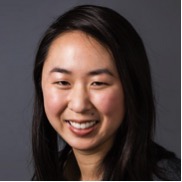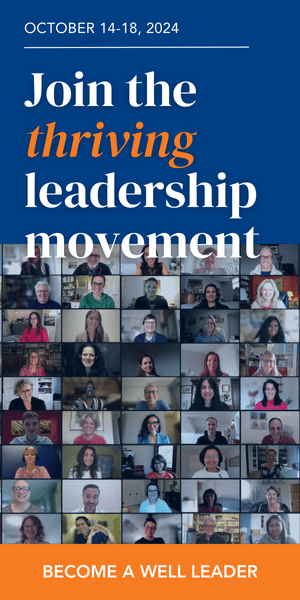 During my last blog post I shared six inspiring quotes from incredible women who are leading wellbeing in work and life. The voice of Maggie Hsu fits right in! Maggie is Chief of Staff to Tony Hsieh, CEO of well-known retailer Zappos.com and Founder of the groundbreaking Downtown Project, a 60-acre, $350-million investment in technology and community to help reinvigorate Las Vegas. Because of her distinctive role, infectious drive, and deeper sense of purpose, Maggie offers a unique lens about how to strategically use innovation for advancing wellbeing. I’m delighted to share her insights as a compelling Face of Wellbeing Leadership.
During my last blog post I shared six inspiring quotes from incredible women who are leading wellbeing in work and life. The voice of Maggie Hsu fits right in! Maggie is Chief of Staff to Tony Hsieh, CEO of well-known retailer Zappos.com and Founder of the groundbreaking Downtown Project, a 60-acre, $350-million investment in technology and community to help reinvigorate Las Vegas. Because of her distinctive role, infectious drive, and deeper sense of purpose, Maggie offers a unique lens about how to strategically use innovation for advancing wellbeing. I’m delighted to share her insights as a compelling Face of Wellbeing Leadership.
Me: What does it mean to lead wellbeing?
Maggie: Let me answer that question both in terms of people and community. In my mind wellbeing is about understanding who people really are, their motivations, and what makes them feel whole, professionally and personally. So, leading wellbeing is first about trying to embody that myself. When I think of what we’re doing at Zappos and the Downtown Project in Las Vegas, leading wellbeing is about renewing the downtown community. In that sense it’s about enabling people to pursue their passions. A lot of people equate wellbeing with being happy all the time. But the way we think about it is this: by enabling people to pursue their deeper passions, they will feel more fulfilled, productive, and thriving through the happy times and unhappy times.
Me: Let’s talk a little about the Downtown Project. How do you see it impacting the wellbeing of Las Vegas?
Maggie: On so many different metrics – heart disease, high cholesterol, STDs, high school graduation rates, binge drinking, and more – Nevada falls well behind other states in the U.S. We’re 47th in overall health. The Downtown Project hopes to help reverse that statistic through the revitalization of downtown Las Vegas. We’ve invested in over 300 different projects and initiatives, from entrepreneurs and tech companies to grocery stores, bars, restaurants and hotels, to the Downtown Container Park, an innovative family center built from re-purposed shipping containers that is all-at-once an entertainment venue, shopping mall, and interactive play zone for kids.
We don’t use a traditional real estate approach where we buy land, get people to move in, make money, and then buy more land. Our central philosophy is people-based, what we call “engineered serendipity.” This means we look for ways to help people collide with each other. We generate these high-collision environments in hopes that people are naturally encouraged to share their ideas with each other, which in turn increases the pace of innovation and uplifts the city. One way we measure progress is by tracking Return On Collision!
A role I have there is to help facilitate those collisions. For example, I look for opportunities where two people in different industries come together to learn from each other and cross-pollinate ideas. Remember the old-fashioned company water cooler? It was there – during a quick break from work tasks – where people got new inspiration by someone or something outside their department. That’s what we’re catalyzing on a city-wide scale. By supporting people in a culture of constant idea sharing we believe we can increase the pace of innovation in the city as a whole.
But that’s not the end game. We’re banking on the idea that innovation can be a driver of wealth and wellbeing. There are loads of new insights such as this research from the Santa Fe Institute that say as the size of the city doubles, the good things about the city also doubles plus an additional 15%. Crime rates and other negatives may rise as well so this kind of growth is not perfect. But every city is a concentration of people and ideas; for Las Vegas we’re trying to evolve that concentration of people and ideas into a culture of responsible innovation, which we think is fuel to raise the wellbeing of the city overall.
It’s a big vision. And one that requires us to experiment, fail at times, and grow together through shared learning. For example, in this innovative environment if new businesses shut down for whatever reason, people very quickly have opportunities at other startups.
Me: Using innovation to foster wellbeing city-wide is fascinating. Can you give me a practical example of how it has worked so far?
Maggie: One interesting community example is an early childhood school we started, 9th Bridge. Students range from six-weeks-old to second grade. The school employs project-based learning, meaning, curriculum around areas of curiosity rather than classes strictly on subjects such as math or English. For instance, a student recently found a snail outdoors and brought it into class; the teachers created a whole set of studies around it. Learning biology and math then became real and relevant for those kids.
On a larger scale for the city, co-learning is our explicit goal. We bring in speakers – the magician David Copperfield, Whole Foods’ CEO John Mackey, and the human calculator Scott Flansburg are a few – who provide the quality of a Ted Talk to interested residents for free. They also go into the schools such as 9th Bridge to give talks. We’ve had local artists work with the students as well. In fact, one first grader was so energized that she decided to sell her art. Inspired by her energy, people helped her set up a booth at First Friday, an art festival that sees about 25,000 people. She sold out of her art pieces!
The point here is that we’ve created an environment where the timeline from idea to execution has dramatically shortened compared to any other city I’ve seen. There’s a drive toward collaboration and partnership … and no excuse for not doing something about an idea that has true passion and purpose behind it. We believe this approach will impact the wellbeing of the individuals who take part, as well as the vitality of the entire city.
READ MORE






